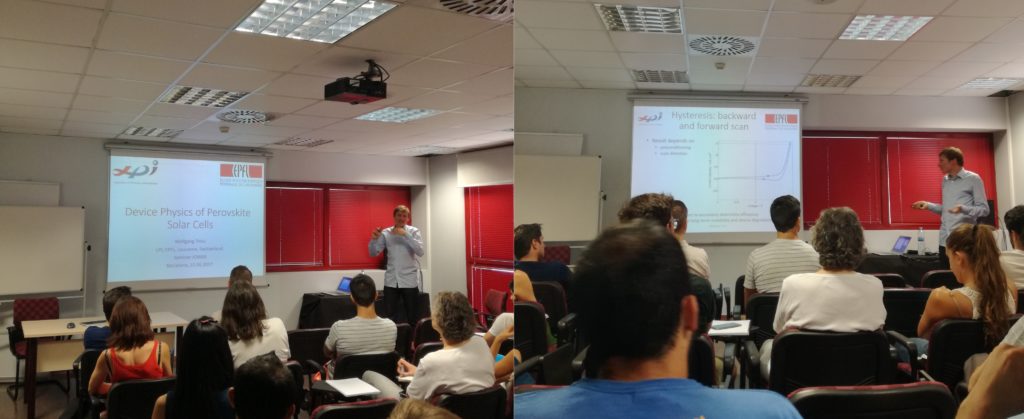Wolfgang Tress from EPFL (Switzerland) gave an Invited Seminarentitled ‘Device Physics of Perovskite Solar Cells’ and hosted by Agustín Mihi
Abstract:
Solar cells based on lead halide perovskites have recently emerged showing a tremendous increase of power-conversion efficiency which exceeded 20 %. In this talk, the device physics of perovskite solar cells is addressed. The focus is on recombination of charge carriers because this process is ultimately limiting open-circuit voltage and fill factor in perovskite solar cells. Different architectures such as planar and mesoporous-TiO2 based devices are presented.
The origin of the open-circuit voltage is discussed based on the reciprocity relation between electroluminescence and photovoltaic quantum efficiency.[1,2] Different recombination mechanisms (radiative, trap-mediated) are investigated and related to the device performance.
Hysteresis in the current-voltage curve is related to recombination as well. It is shown how different prebias voltages influence recombination rates.[3] The results are explained by the mixed ionic and electronic conductivity of the material, where displaced ions change interface and defect recombination. A recently discovered inverted hysteresis and reversible photo-induced degradation mechanisms on the timescale of minutes to hours are put into the framework of ion migration as well.[4]
An outlook is given on strategies aiming for a further improvement of the open-circuit voltage.
[1] Tress, W. et al. Predicting the Open-Circuit Voltage of CH3NH3PbI3 Perovskite Solar Cells Using Electroluminescence and Photovoltaic Quantum Efficiency Spectra: the Role of Radiative and Non-Radiative Recombination. Adv. Energy Mater. 5, 140812 (2015). [2] Bi, D. et al. Efficient luminescent solar cells based on tailored mixed-cation perovskites. Sci. Adv. 2, e1501170 (2016). [3] Tress, W. et al. Understanding the rate-dependent J–V hysteresis, slow time component, and aging in CH3NH3PbI3 perovskite solar cells: the role of a compensated electric field. Energy Environ. Sci. 8, 995–1004 (2015). [4] Tress, W. et al. Inverted Current–Voltage Hysteresis in Mixed Perovskite Solar Cells: Polarization, Energy Barriers, and Defect Recombination. Adv. Energy Mater. 6, 1600396 (2016).


